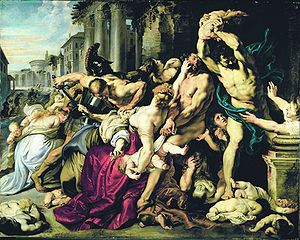- Massacre of the Innocents (Rubens)
-
 Peter Paul Rubens. Massacre of the Innocents
Peter Paul Rubens. Massacre of the Innocents
The Massacre of the Innocents is the title of either of two paintings by Peter Paul Rubens depicting an episode of the biblical Massacre of the Innocents as related in the Gospel of Matthew.
Contents
The lost masterpiece
The first version painted by Rubens dates from around 1611–12. In the seventeenth-century , the painting was part of the Liechtenstein Collection in Vienna, Austria, along with another Rubens' masterpiece, Samson and Delilah. After having been miscatalogued by Vincenzio Fanti in 1767, it was attributed to one of Rubens' assistants, Jan van den Hoecke, after Rubens. There, however, it remained until it was sold to an Austrian family in 1920. It was subsequently loaned in 1923 to Stift Reichersberg, a monastery in northern Austria.
In 2001, the painting was seen by George Gordon, an expert in Flemish and Dutch paintings at Sotheby's in London. He was persuaded that it was indeed a Rubens by its similar characteristics and style to the Samson and Delilah picture, painted at around the same time. The work was sold at auction at Sotheby's, London on July 10, 2002 for £49.5 million (CAD $117 Million)[1] to Canadian businessman Kenneth Thomson, 2nd Baron Thomson of Fleet.
Following the auction the painting was loaned to the National Gallery, London for a period before its transfer in 2008 to the Art Gallery of Ontario in Toronto, to whom Thomson had donated it, and which was undergoing a major rebuilding and expansion during those years. [2]
Analysis
It is widely regarded as a demonstration of the artist's learnings from his time spent in Italy between 1600 and 1608, where he observed first-hand the works of Italian Baroque painters like Caravaggio. These influences are seen in this painting through the sheer drama and emotive dynamism of the scene, as well as the rich colour. There is also evidence of the use of chiaroscuro.
Later version
Towards the end of his life, between 1636 and 1638, Rubens painted a second version of the Massacre of the Innocents. This version was acquired by the Alte Pinakothek, Munich by 1706, and it continues to hang there today.[3]
A copy of this later version was made as an engraving in 1643 by Paulus Pontius.[4]
Notes
External links
Peter Paul Rubens Infante Isabella Clara Eugenia (1566-1633) · The Deposition (1602) · Equestrian Portrait of the Duke of Lerma (1603) · Portrait of a Young Woman (1603) · Virgin and Child (c. 1604) · Marchesa Brigida Spinola-Doria (1606) · Susanna and the Elders (1607) · Samson and Delilah (1609-1610) · Honeysuckle Bower (1609-1610) · Raising of the Cross (1610-1611) · Massacre of the Innocents (c. 1611) · Prometheus Bound (1611-1612) · Descent from the Cross (1611–1614) · St Sebastian (c. 1614) · The Hippopotamus and Crocodile Hunt (1615-1616) · Romulus and Remus (1615-1616) · Adoration of the Magi (1616-1617) · The Fall of the Damned (ca. 1620) · Saint George and the Dragon (c. 1620) · Perseus Freeing Andromeda (1620) · Marie de' Medici cycle (1621–1630) · Assumption of the Virgin Mary (1625-1626) · The Fall of Man (1628–1629) · The Feast of Venus (c. 1635) · Consequences of War (c. 1638) · The Three Graces (1636-1638) · Judgment of Paris (c. 1638-1639)
 Categories:
Categories:- Rubens paintings
- 1612 paintings
- 1638 paintings
- Christmas art
- Collection of the Alte Pinakothek
- Collections of the Art Gallery of Ontario
- Paintings depicting death
- Paintings with biblical themes
- Thomson family
- Herod the Great in popular culture
Wikimedia Foundation. 2010.

